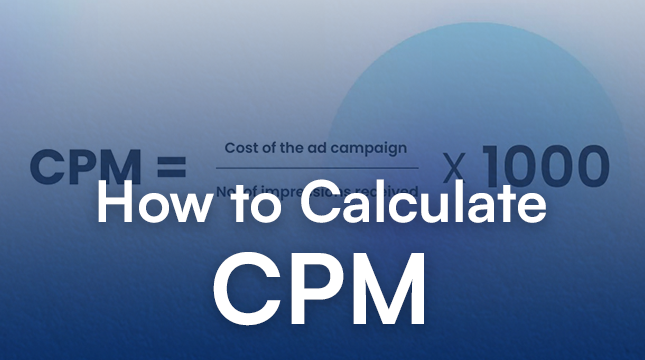How to Calculate CPM | Netizens Technologies

In the world of digital marketing, understanding how to measure the effectiveness of your advertising efforts is crucial. One of the most commonly used metrics is CPM, or Cost Per Mille, which essentially measures the cost of 1,000 ad impressions. But how exactly do you calculate CPM, and why is it so important? In this article, we’ll dive deep into everything you need to know about CPM, including how to calculate it, why it matters, and how you can use it to optimize your advertising campaigns.
What is CPM?
CPM stands for Cost Per Mille, with “mille” being the Latin word for thousand. In simple terms, CPM is the cost an advertiser pays for one thousand impressions of their ad. An impression is counted each time an ad is shown to a user, regardless of whether the user clicks on it. This metric is crucial for advertisers who want to understand the cost-effectiveness of their campaigns, particularly when their goal is to maximize visibility and brand awareness.
Why is CPM Important?
CPM is a vital metric in the digital advertising space for several reasons:
- Impact on Advertising Budget: By knowing the CPM, advertisers can budget more effectively. It helps in determining how much to spend to achieve a desired number of impressions.
- Influence on Campaign Performance: CPM allows advertisers to gauge the efficiency of their ad placements and make necessary adjustments to improve performance.
Read More : B2B Digital Marketing Services
Basic Formula for Calculating CPM
The basic formula for calculating CPM is straightforward:
CPM=(Total CostTotal Impressions)×1000\text{CPM} = \left( \frac{\text{Total Cost}}{\text{Total Impressions}} \right) \times 1000
Understanding this formula is the first step toward accurately calculating your CPM and making informed decisions about your advertising strategy.
Step-by-Step Guide to Calculate CPM
Let’s break down the steps to calculate CPM:
- Determine Total Cost: This is the total amount spent on the ad campaign.
- Calculate Total Impressions: This is the number of times the ad was displayed.
- Apply the CPM Formula: Plug these values into the CPM formula to get your result.
Examples of CPM Calculation
To make this clearer, let’s look at a couple of examples:
- Example 1: Simple Calculation Suppose you spent $500 on an ad campaign and your ad was displayed 200,000 times. The CPM would be: CPM=(500200,000)×1000=$2.50\text{CPM} = \left( \frac{500}{200,000} \right) \times 1000 = \$2.50
- Example 2: Complex Scenario Imagine you have a more complex campaign with multiple ads and varying costs. Let’s say you spent $1200 on a series of ads that garnered a total of 450,000 impressions. The CPM calculation would be: CPM=(1200450,000)×1000=$2.67\text{CPM} = \left( \frac{1200}{450,000} \right) \times 1000 = \$2.67
Factors Affecting CPM Rates
Several factors can influence CPM rates:
- Ad Placement: Premium locations (e.g., homepage, above the fold) typically have higher CPMs.
- Target Audience: Ads targeting specific demographics or high-value audiences can cost more.
- Time of Year: Seasonal demand, like holidays, can drive up CPM rates due to increased competition.
CPM in Different Advertising Platforms
Different platforms may have varying CPM rates:
- Google Ads: Known for its broad reach and detailed targeting, but can be costly.
- Facebook Ads: Often more affordable with powerful targeting options.
- Instagram Ads: Generally higher CPMs due to the visual nature and engaged user base.
Comparing CPM with Other Metrics
It’s essential to understand how CPM compares to other advertising metrics:
- CPM vs CPC (Cost Per Click): While CPM measures cost per thousand impressions, CPC focuses on the cost per click. CPC is better for direct response campaigns, whereas CPM is ideal for brand awareness.
- CPM vs CPA (Cost Per Acquisition): CPA measures the cost to acquire a customer, making it useful for conversion-focused campaigns.
- CPM vs CTR (Click-Through Rate): CTR measures the percentage of impressions that result in a click, indicating the effectiveness of the ad’s call to action.
Optimizing Your CPM
To get the most out of your CPM, consider these tips:
- Reduce CPM: Use targeted advertising to avoid paying for irrelevant impressions. A/B testing can help refine your ads.
- Increase Ad Impressions: Improve your ad content and placement to naturally attract more views without increasing costs.
CPM and ROI (Return on Investment)
Calculating ROI in the context of CPM involves assessing the revenue generated from the impressions:
ROI=(RevenueTotal Cost)×100\text{ROI} = \left( \frac{\text{Revenue}}{\text{Total Cost}} \right) \times 100
Balancing the cost (CPM) and effectiveness (ROI) ensures your ad campaigns are both cost-effective and impactful.
Read More : Top 5 Marketing Agencies Chicago
Common Mistakes in Calculating CPM
Avoid these common pitfalls:
- Misinterpreting Impressions: Ensure you understand what counts as an impression on different platforms.
- Ignoring Hidden Costs: Consider all costs involved, including creative development and management fees.
Tools for Calculating and Analyzing CPM
Leverage these tools to streamline your CPM calculations:
- Online CPM Calculators: Simple and quick way to compute CPM.
- Analytics Platforms: Use tools like Google Analytics to track and analyze your campaign performance comprehensively.
Real-World Applications of CPM
To see CPM in action, consider these scenarios:
- Case Studies: Analyze successful campaigns from brands that utilized CPM effectively.
- Industry-Specific Examples: Different industries may have varying average CPMs. For example, the finance sector might have higher CPMs compared to the entertainment industry due to the value of their target audience.
Conclusion
Understanding and calculating CPM is essential for anyone involved in digital advertising. It helps you manage your budget, optimize your campaigns, and ultimately achieve better results. By mastering CPM, you can ensure that your ads are cost-effective and reach the right audience at the right time.

Let's Start Your Project
Get free consultation for your digital product idea to turn it into reality!
Get Started








